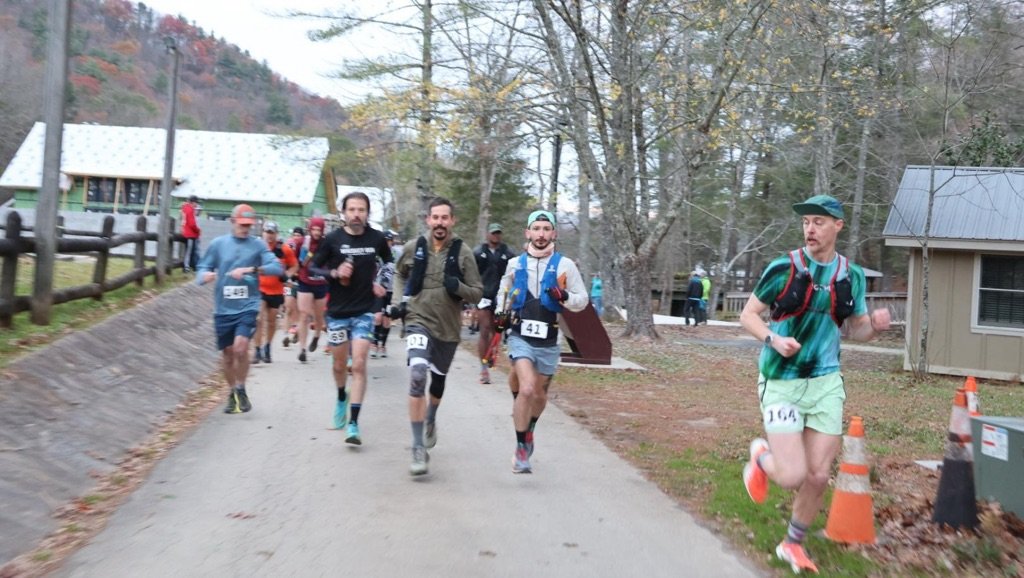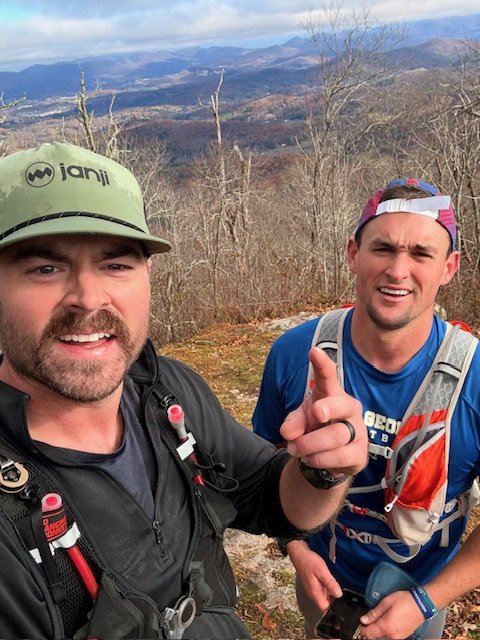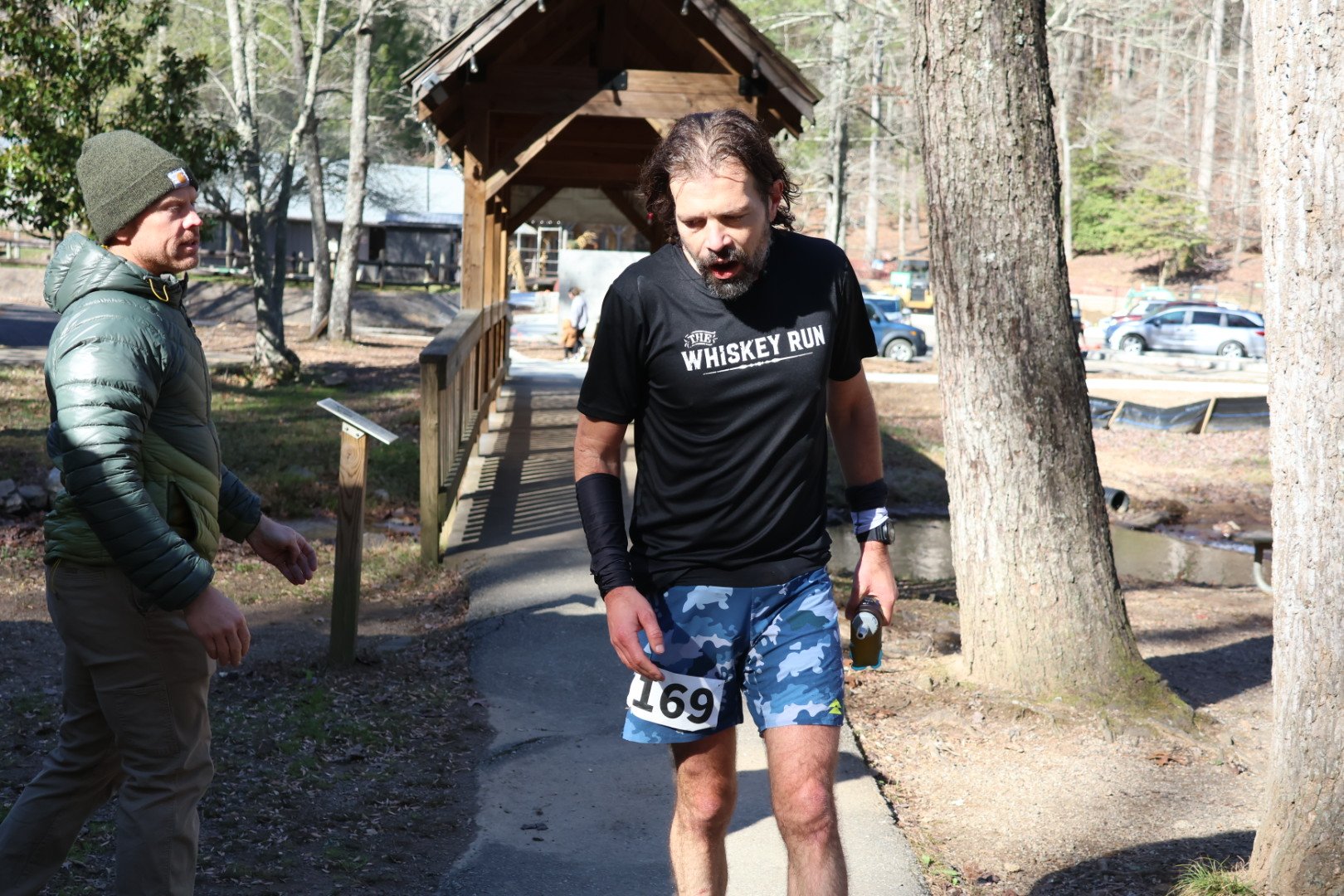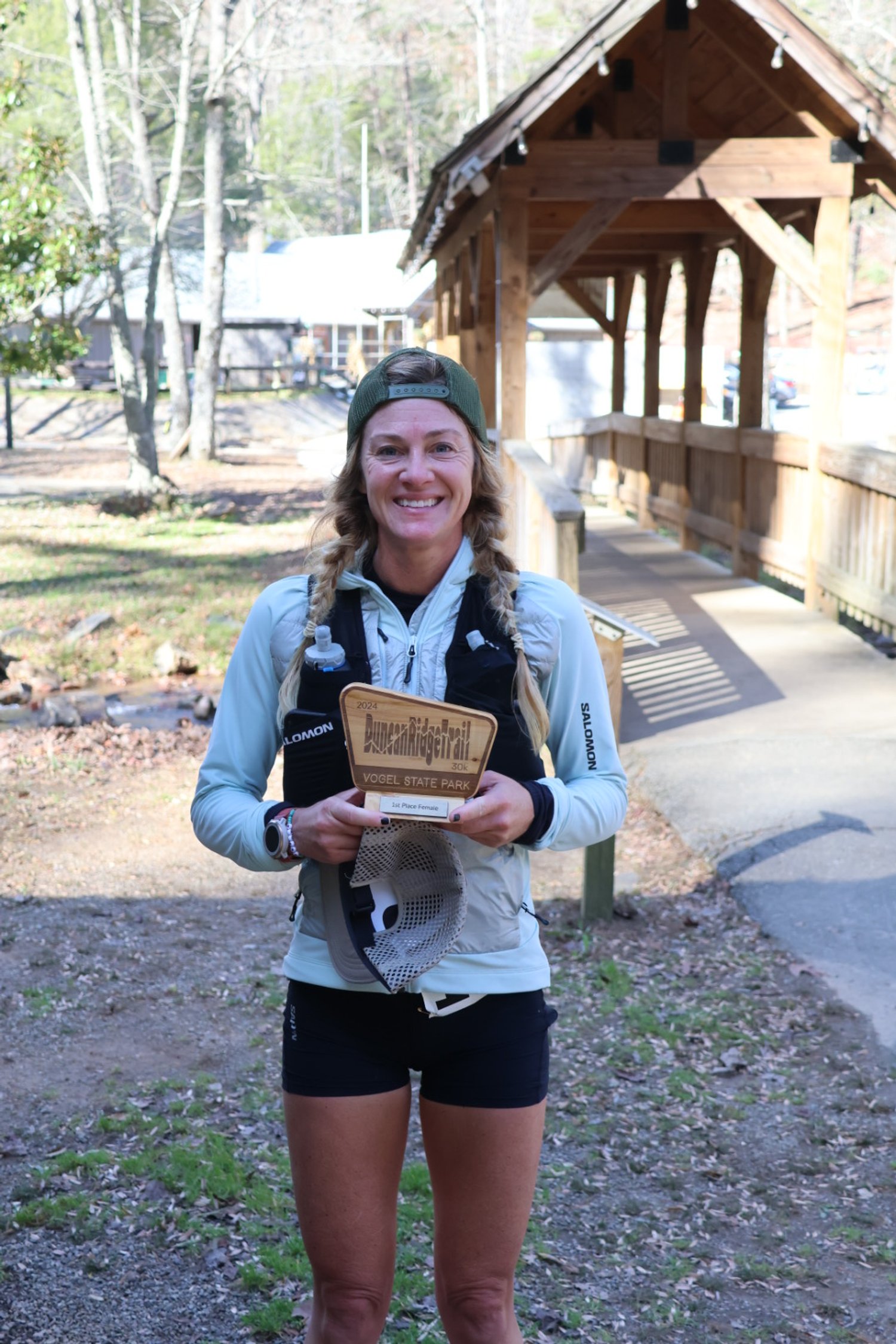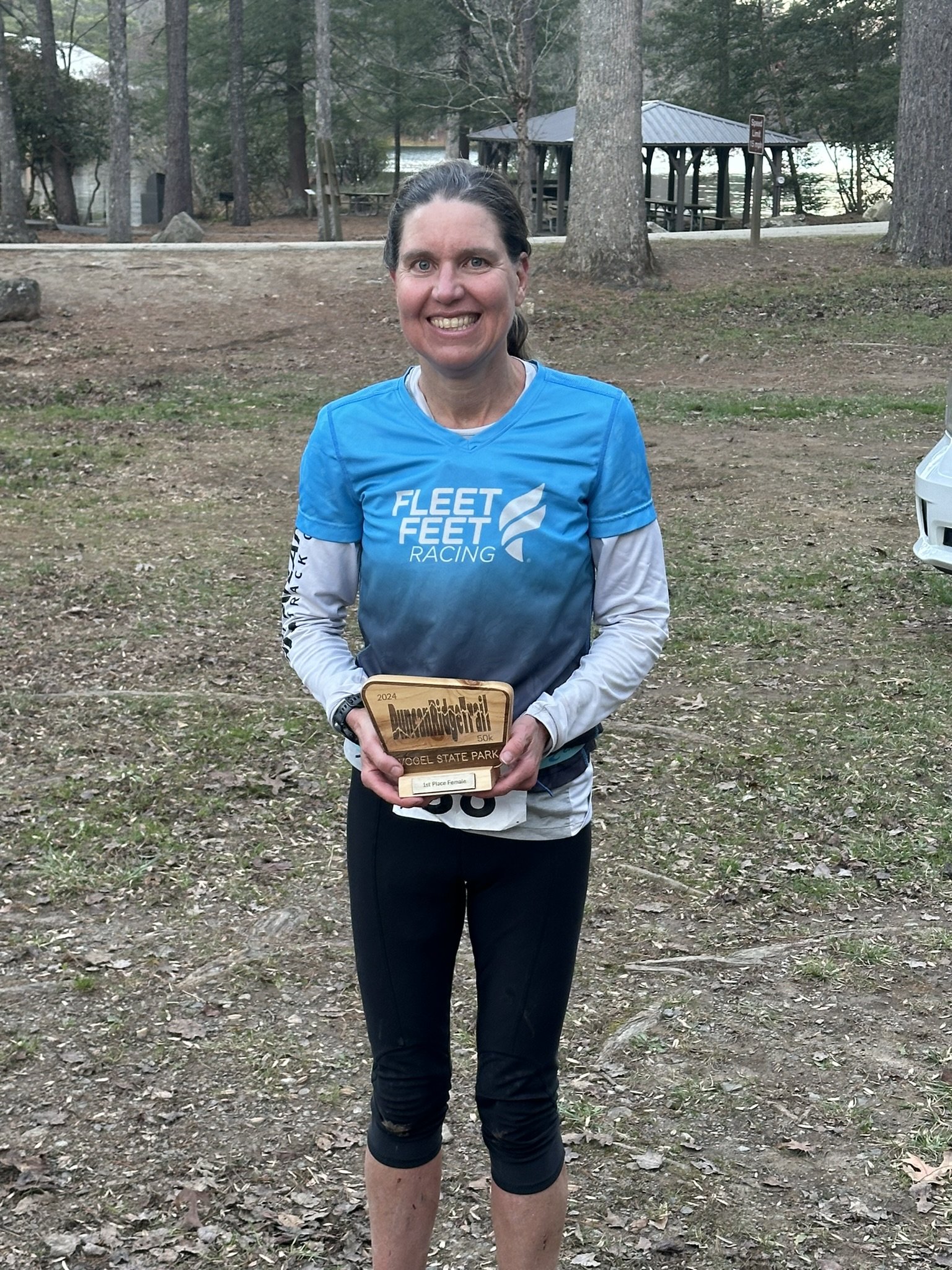Duncan Ridge Trail Race 50K
If you invited most of the people you know to take a casual hike with you the response would reflect the diversity of your tribe. When you explained the quiet hike would climb 10,000 feet of elevation gain the list of potential hikers would immediately dwindle to a dedicated few friends who love a challenge. The list would get smaller if you mentioned the 11-hour cutoff for the 30 miles through some of the steepest climbs in the Blue Ridge Mountains.
This is how 100 trail runners found themselves at the start of the Duncan Ridge Trail (DRT) Race on 23 November 2024. The race featured a 30K and 50K distance with only 30% of the runners choosing the full course. The start found the runners anxiously awaiting the 0730 start. The atmosphere was electric with anticipation of the challenges that lied ahead. Each runner faced the same course while their challenges would be as diverse as the collection of lives they represented.
Vogel State Park’s beauty presented a stark contrast to the daunting task ahead of the runners. The park sits on a beautiful lake nestled into the north Georgia mountains in Blairsville., Georgia. The temperature at the start line was an icy mid-30 degrees. The mountain peaks surrounding the park were all solid white showing the below freezing conditions awaiting the runners after their long climb.
The climbing is relentless to reach the white-capped peaks ahead. The first six miles connected each runner to the Duncan Ridge Trail via the Coosa Backcountry Trail. The trail features numerous sections that have a steep grade of 20-30% for long hikes. Several runners could be found on the side of the trail adjusting their shoes from heel slippage. Time was against these runners as the clock never stopped and cutoff times crept closer.
The aid stations were an oasis filled with any needed resource you could imagine. The volunteers cheerfully served each runner food, snacks, water, and even whiskey. Runners had the chance to warm their chilled bodies while numbing their pounding feet. The hardest part each race was leaving these sanctuaries filled with smiling faces to continue the climb towards the finish.
The north Georgia trails feature more challenges than climbs in late November. The fall season has nearly ended at this time making the trails a leaf-filled hazard for hikers. Trail runners have the additional challenge of trying to maintain the fastest pace possible while navigating the landmines hidden under the leaves. Each step is a choice that could prove fatal if a lapse of attention occurs.
The Georgia trails are known for the abundance of veiny wet roots, loose rocks, ice covered solid rocks, and the ever-hated “toe-stubbers” that poke the toe of your running shoe as you run. When these hazards are covered in leaves it makes for an exciting adventure akin to playing the lottery with every step. The best technical runners can navigate these hazards with ease to push their pace up or down. An average trail runner can find themselves trapped inside their mind wondering when the next step could be their last if a wrong choice is made.
The DRT course was made even harder at the highest elevation points where the solid rocks also had ice covering them. The ice-covered trees bombarded the trail with rectangular ice chunks as the temperatures improved to a sunny 40 degrees with a consistent breeze. This pattern of challenges continued the entire course from Vogel to the turnaround at Fish Gap.
The race was not impossible. It was very attainable for each runner. This did not mean it was something everyone would achieve as only 50% of the runners in the 50K race finished. The runners were eliminated one by one until there were only 16 runners who claimed the coveted finish on this extremely tough course.
The race winner would finish as the only runner to break 7 hours in the 50K. Callen Hasling, of Marietta, Georgia, took home the 2024 first place male and overall title. He improved his 2023 winning time by over 45 minutes to win his second consecutive DRT 50K.
The overall female winner was Wendy Mader, also of Marietta Georgia, who finished her race in 9:28:38 hours. She edged out Sara Duncan, of Waynesville, North Carolina, by only 30 minutes. They were the only two females to complete the 50K course.
Zack Wilson, of Signal Mountain, Tennessee, and Aden St. Charles, of Chattanooga, Tennessee were the 30K winners. They led a group of 63 finishers for the race. The last runner finished at 7:28:37 hours with a 94% finish rate for the 30K race.
In the end, 100 people faced the impossible task. Some would win. Others would learn. All were extremely challenged on the Duncan Ridge Trail.
How My Race Went.
How hard is The Duncan Ridge Trail Race (DRT)? The race is arguably one of the hardest on the East Coast. The course packs 10,000 feet of elevation gain into a short 50K distance. This would be a challenge for most runners to complete with no clock. The strict time cutoffs make the race more formidable as there is no precious time to waste along the trail.
The course is a brutal out-and-back that at Vogel State Park in Blairsville, Georgia. There is no relief on the course. You first climb out of the beautiful state park up to the Coosa Backcountry Trail for a long five-mile climb up to the Duncan Ridge Trail. The ridge is a relentless journey with a higher difficulty due to the heavy leaf covering of the trail. Runners must climb 15.5 miles all the way to Fish Gap then return to the start. There are four aid stations each runner must check-in to ensure they meet the strict cutoff times for each one. If you are a minute late your race is over.
The race is hard enough for only 38 runners signup to attempt the race on 23 November 2024. The 2024 race ended with less than 50% competition rate. The challenge was as hard as advertised.
Race day was very cold starting in the low 30’s making the need to stay warm very important for me as an anemic runner. I choose to wear long pants, a short-sleeved shirt, a long-sleeved shirt, a hoodie, and my Nathan vest as my race kit for the day. I sacrificed maneuverability to help my body maintain body heat. The course got colder as we climbed to the summit along the ridge. The highest parts of the course were solid white with ice that covered every bush, rock, and tree. The scene was surreal like a Coca-Cola commercial with the wind blowing the rectangular-shaped ice pieces from the trees bombarding all the runners on the trail as they passed.
My day started off with important decisions to meet these difficult challenges. I debated using my poles for the race. I tend to not use poles if I do not have to use them. I have run the trails around Vogel State Park extensively in races and training. I felt comfortable running without poles on most of the trails in the area. I twice stopped myself from returning to my bus to get them before heading out on the course. I decided I wanted to face the challenge without them. I think this was my first critical mistake of the race.
The course is very technical. The poles could have given more support in the icy, rocky, leaf-stricken points where my pace slowed when my footing was questionable. The lack of confidence in my footing was critical to my required pace to complete the race. Potentially the poles could have saved me from turning my ankle twice on the icy, leave-covered rocks. Poles would have also given me more confidence which would have manifested in higher pace of elevation gain per hour.
I believe this stat is the most important for a race like the DRT. Only elite runners can run most of the course due to the steep climbing. I must pay attention to maximizing the time I spend on all the controllable aspects of the race. I must always keep moving. I must never stop at aid stations for more than the time it takes to restock calories and fluids. DRT requires you to maintain a pace of 1000 feet of elevation gain per hour to meet the minimum cutoff time. When you fall behind this pace your race is in jeopardy of ending.
My final pace average was 785 feet of gain per hour. My poles would have improved this stat. I made the error to suffer needlessly. The decision was fatal.
No race you attempt is a loss. Each is an opportunity to learn more skills to be a better version of yourself. The way you handle the adversity you face on the trail is an actionable experience you can apply to anything in your life.
I learned I can complete the DRT. I have to trust my instincts when deciding gear. If something is allowed use it to your advantage. I recommend anyone who attempts DRT to use their poles. Trust yourself as you know your capabilities. You do not have to mirror other runners to be successful. Run your own race.
Is DRT too hard? Failure is not an indication of attainability. The race is achievable for all runner levels with the correct training. This race will challenge any level runner. If you want a hard challenge then I recommend the 2025 DRT as a must-race event for your schedule.
